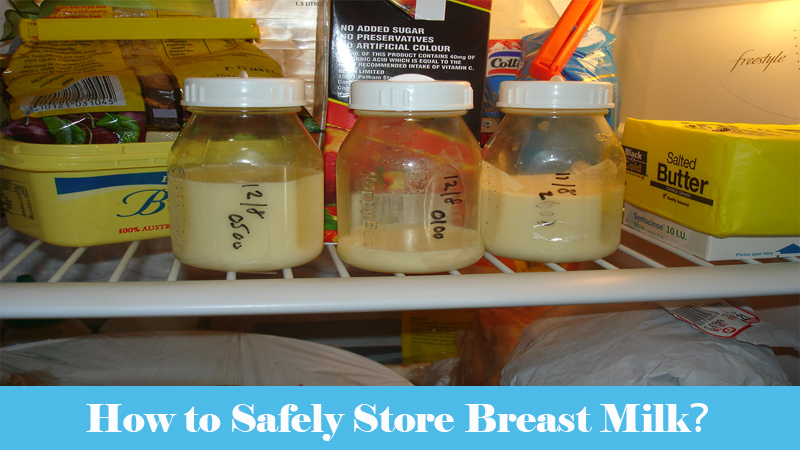Table of Contents
If you are breastfeeding your baby and want to work again, you may need to start expressing milk and storing it for future use. Expression and storage can also make your routine more flexible. For the safety of infants, breast milk needs to be stored safely. Read tips on storing breast milk.
The way you store breast milk depends on how long you want to use it. If you plan to use it within a few days, refrigeration is better than freezing. Frozen milk will mean that it loses some nutrition to fight infection, but frozen breast milk is still better for infants than formula milk.
Watch this video “HOW TO PROPERLY STORE, FREEZE, & THAW YOUR BREASTMILK”(10mins 31 seconds)
After each pumping, you can:
Keep the milk at room temperature.
After pumping at room temperature (up to 77°F), breast milk can last 4 hours.
refrigeration. Breast milk can be kept in the refrigerator for 4 days.
Put the milk in the refrigerator. If you do not plan to use refrigerated breast milk within 4 days after pumping, please freeze it immediately after pumping.
Use ice packs.
After pumping, you can put breast milk in a refrigerated or insulated refrigerated bag with a frozen ice pack for up to 24 hours. After 24 hours in the cooler, breast milk should be refrigerated or frozen.
When storing breast milk, use a breast milk storage bag for freezing breast milk. You can also use clean glass bottles or rigid BPA-free plastic bottles with tight caps. Do not use containers with a recycling number of 7, which may contain BPA. Do not use disposable bottle linings or other plastic bags to store breast milk.
Storage bottles or storage bags for refrigerated or frozen breast milk can also be used as tax-deductible breastfeeding tools. In addition to breast pumps, most insurance plans must also cover breastfeeding supplies, such as storage bags. Call your insurance company for more information.
Whether you choose refrigerated or frozen milk, you should:
- Use sterile containers. Choose plastic bottles or plastic breast milk bags. The glass bottle may crack or shatter.
- Label and date bottles and bags, then use up the oldest bottles and bags first.
- Keep the breast pump clean. Wash the parts in hot soapy water and rinse them thoroughly before disinfecting.
- Wash your hands before milking and handling breast milk. Keep everything as clean as possible to reduce the possibility of bacteria growing in the stored milk.
Breast milk storage solutions
Bags
If you are using a storage bag, fill it up to three quarters to allow expansion when frozen. To avoid chaos caused by the storage bag tearing, you may need to put the storage bag in a sealed plastic container.
bottled
Many breast pumps come with some bottles, you can use them to store milk and give it to your baby, you can buy more if needed. You can also use regular baby bottles, even the cups with lids can be closed tightly. Fill three-quarters again to expand when the bottle freezes.
Whether you are using a bottle or a bag, you should try to avoid BPA. This BPA is a chemical found in certain plastics. This chemical has been shown to affect the endocrine system in animal studies. Babies are especially problematic. Avoid using bottles with the number 7 recycling symbol and the letters PC, because many of them contain BPA.
Although not very common, you can also find BPA-free milk storage bags. If your milk is to be stored in a day care facility or other childcare facility, please make sure that the child’s name and date are clearly marked on the milk.
Remember, you don’t have to heat breast milk. If you haven’t done so already, it’s best to avoid letting your little children get into the habit of taking hot milk, because this is an extra step and has no health benefits. However, if you want to heat or thaw breast milk, make sure not to use a microwave. Doing so can interfere with nutrition and cause uneven heating of the milk, which can accidentally burn your baby’s mouth. It is best to warm the milk with warm water (rather than hot water) and then test it before feeding the baby. Make sure the top of the bottle is firm to prevent water from entering the container and contaminating the container.
Guidelines for the safe storage of breast milk
Room temperature
Newly extracted breast milk can be stored at room temperature (not higher than 77 degrees Fahrenheit). Ideally, they can be stored for up to four hours as long as they are not in direct sunlight or near other heat sources. In some cases, it may be able to be stored at room temperature for up to six hours, especially if it is not so warm or the room is on the cooler side.
In refrigerator
Breast milk can be kept in the refrigerator for up to four days. Check the temperature of the refrigerator to make sure it is around 40 degrees Fahrenheit and store the loot on the back of the coldest refrigerator. Avoid placing breast milk on the refrigerator door, because when the door is opened, the refrigerator is most susceptible to warm air. Four days later, it’s time to move the milk to the refrigerator.
This is general information and cannot replace your healthcare provider’s advice. If you have a problem that cannot be solved quickly, please seek help immediately. Every baby is different. If in doubt, please contact your doctor or healthcare provider.


